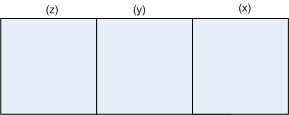Sponsor Area
Permutations And Combinations
Question
How many 3-digit odd numbers can be formed from the digits 1,2,3,4,5,6 if:
(a) the digits can be repeated (b) the digits cannot be repeated?
Solution

(a) Number of digits available = 6
Number of places [(x), (y) and (z)] for them = 3
Repetition is allowed and the 3-digit numbers formed are odd
Number of ways in which box (x) can be filled = 3 (by 1, 3 or 5 as the numbers formed are to be odd)
 m = 3
m = 3
Number of ways of filling box (y) = 6 (∴ Repetition is allowed)
 n = 6
n = 6
Number of ways of filling box (z) = 6 (∵ Repetition is allowed)
 p = 6
p = 6
∴ Total number of 3-digit odd numbers formed
= m x n x p = 3 x 6 x 6 = 108
(b) Number of ways of filling box (x) = 3 (only odd numbers are to be in this box )
 m = 3
m = 3
Number of ways of filling box (y) = 5 (∵ Repetition is not allowed)
 n = 5
n = 5
Number of ways of filling box (z) = 4 (∵ Repetition is not allowed)
 p = 4
p = 4
∴ Total number of 3-digit odd numbers formed
= m x n x p = 3 x 5 x 4 = 60.
Repetition is allowed and the 3-digit numbers formed are odd
Number of ways in which box (x) can be filled = 3 (by 1, 3 or 5 as the numbers formed are to be odd)
Number of ways of filling box (y) = 6 (∴ Repetition is allowed)
Number of ways of filling box (z) = 6 (∵ Repetition is allowed)
∴ Total number of 3-digit odd numbers formed
= m x n x p = 3 x 6 x 6 = 108
(b) Number of ways of filling box (x) = 3 (only odd numbers are to be in this box )
Number of ways of filling box (y) = 5 (∵ Repetition is not allowed)
Number of ways of filling box (z) = 4 (∵ Repetition is not allowed)
∴ Total number of 3-digit odd numbers formed
= m x n x p = 3 x 5 x 4 = 60.
Some More Questions From Permutations and Combinations Chapter
Determine K, so that K + 2, 4K – 6 and 3K – 2 are three consecutive terms of an A.P.
Sponsor Area
Mock Test Series
Mock Test Series





